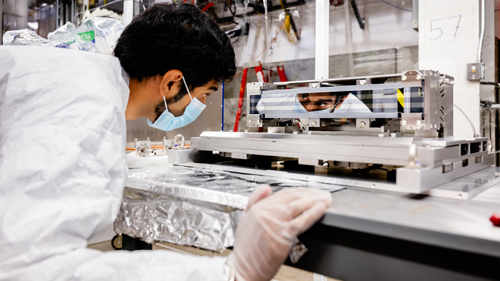| Techniques | X-ray circular and linear dichroism, dichroic ptychography and tomography, extreme conditions. |
| Photon beam energy | 2.7-27 keV |
| X-ray spot size | Down to 100nm |
| Polarization | Circular/variable linear |

Scientists are finding it increasingly relevant to understand more of what is happening during basic, underlying electronic responses. With such knowledge, scientists believe they can develop lighter, better, smaller, more energy-efficient materials and technologies. They can also further investigate the electronic states that may form the basis for qubits, the tiny building blocks of quantum computing.
Enter the POLAR Beamline at 4-ID, one of the new feature beamlines of the Advanced Photon Source (APS) Upgrade project. The POLAR Beamline will be unmatched in its ability to look at the atomic electronic properties of new materials.
Its state-of-the-art focusing optics and extreme sample environments will combine with improved X-ray polarization control to create a uniquely superb beamline. It will do so by manipulating the polarization – the direction of the electric field – of the X-ray beams produced by the upgraded APS.
While most beams produced at the APS have one type of polarization (linear-horizontal), the POLAR beamline will have multiple types of polarization, including linear-horizontal, linear-vertical, elliptical, and circularly rotating (clockwise and counter-clockwise). The different X-ray polarizations, together with the ability to tune, or match, the energy of X-ray beams to element-specific atomic resonances, allow for an extremely sensitive probe of a sample.
The previous beamline at 4-ID produced polarized X-ray beams, but they were less powerful. The new feature beamline at 4-ID will be able to manipulate focused polarized X-ray beams which are 100 to 200 times more powerful and more coherent than was possible with the original APS. This is important because it will allow scientists to explore new states of matter at extreme pressure conditions and see (by way of taking measurements) internal electronic and magnetic structure at the nanoscale.
The previous polarized beamline focused X-rays to 20 microns – similar to the diameter of a human hair – while the new POLAR beamline will be able to focus to 100 nanometers (smaller by a factor of more than 100); a nanometer is a unit of measure small enough to measure a single strand of human DNA.

Furthermore, the POLAR beamline will include a versatile diffractometer to probe complex electronic and magnetic responses under variable conditions, including temperature, electric and magnetic field, and strain. The beamline will also include a large bore superconducting magnet to accommodate diamond anvil cells. Coupled with small, powerful X-rays beams, these improvements will allow scientists to create states of high pressure in the laboratory that are comparable to the pressure of millions of earth atmospheres.
External pressure brings atoms together and increases the overlap between electrons. This changes the electronic properties of materials, sometimes transforming insulators into metals and metals into superconductors. Such interplay between structure and material properties, particularly in electrical conductivity and heat transport, is interesting to scientists because of its relevance to the future of quantum computing and cybersecurity, where encryption and the protection of information grow increasingly complex. Scientists also see potential applications in the development of low-power microelectronics.
Whether advancing electronics in devices as small as computer chips, as large as generators in the heads of enormous wind turbines, or in quantum computers of the future, the POLAR beamline provides an exciting step forward for researchers using the APS to advance science and technology.
BEAMLINE CONTACTS:
Daniel Haskel, [email protected]
Joerg Strempfer, [email protected]
